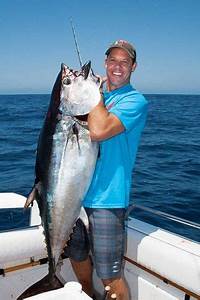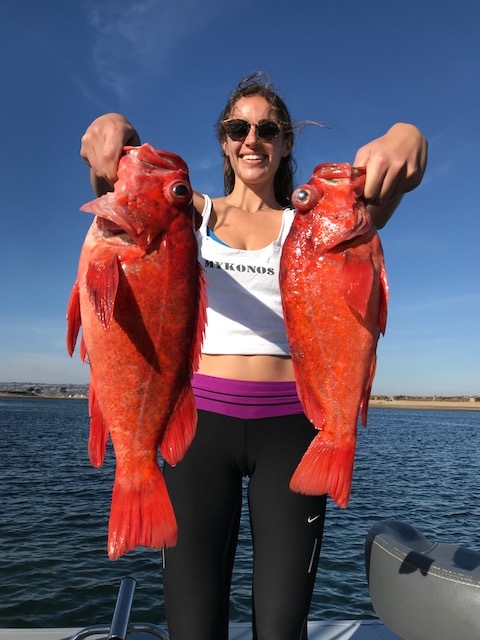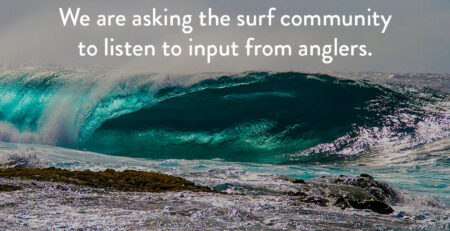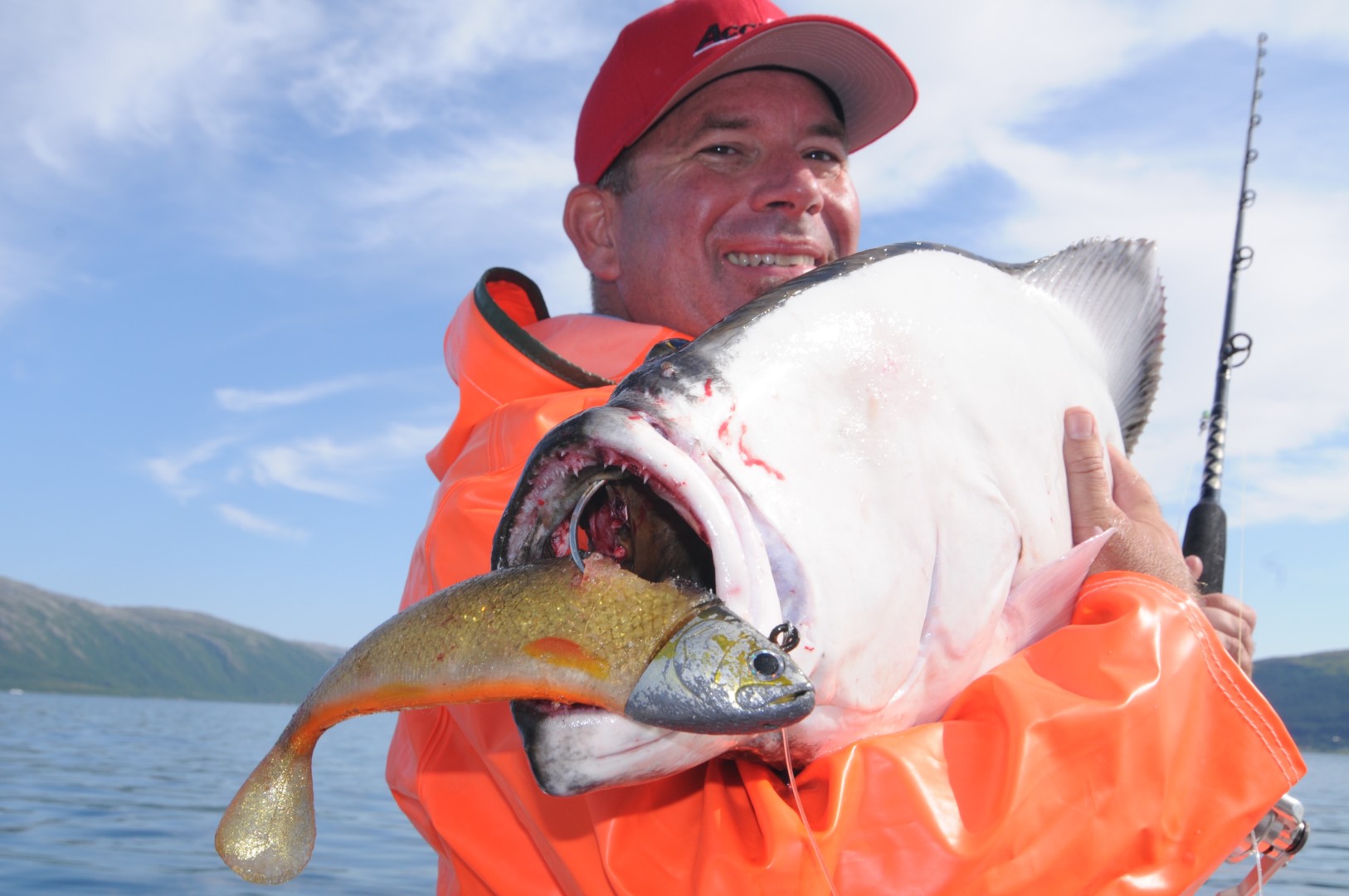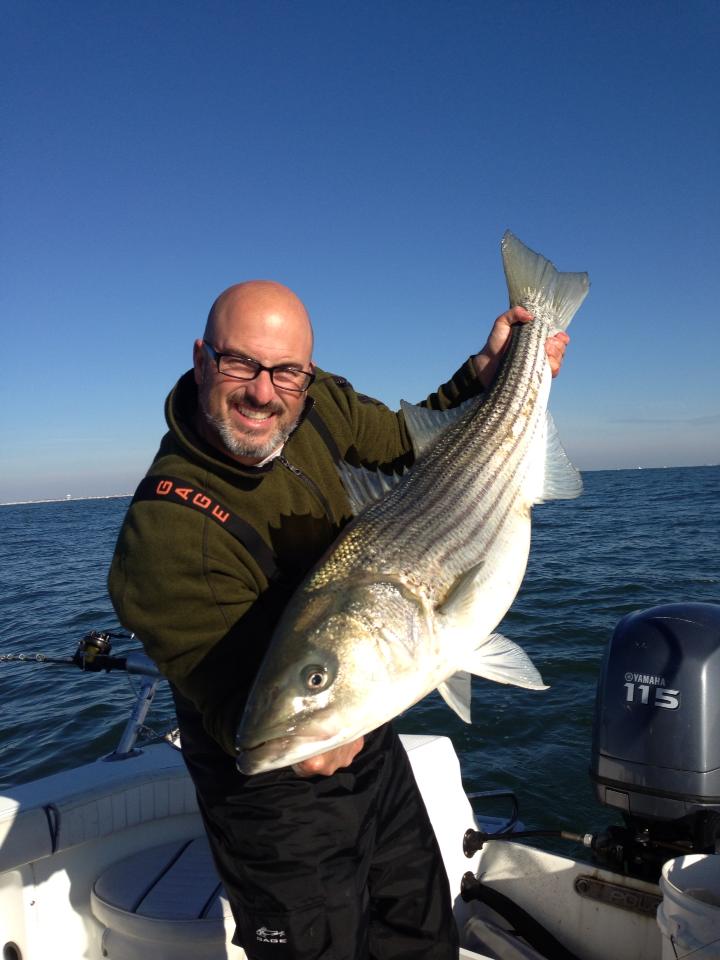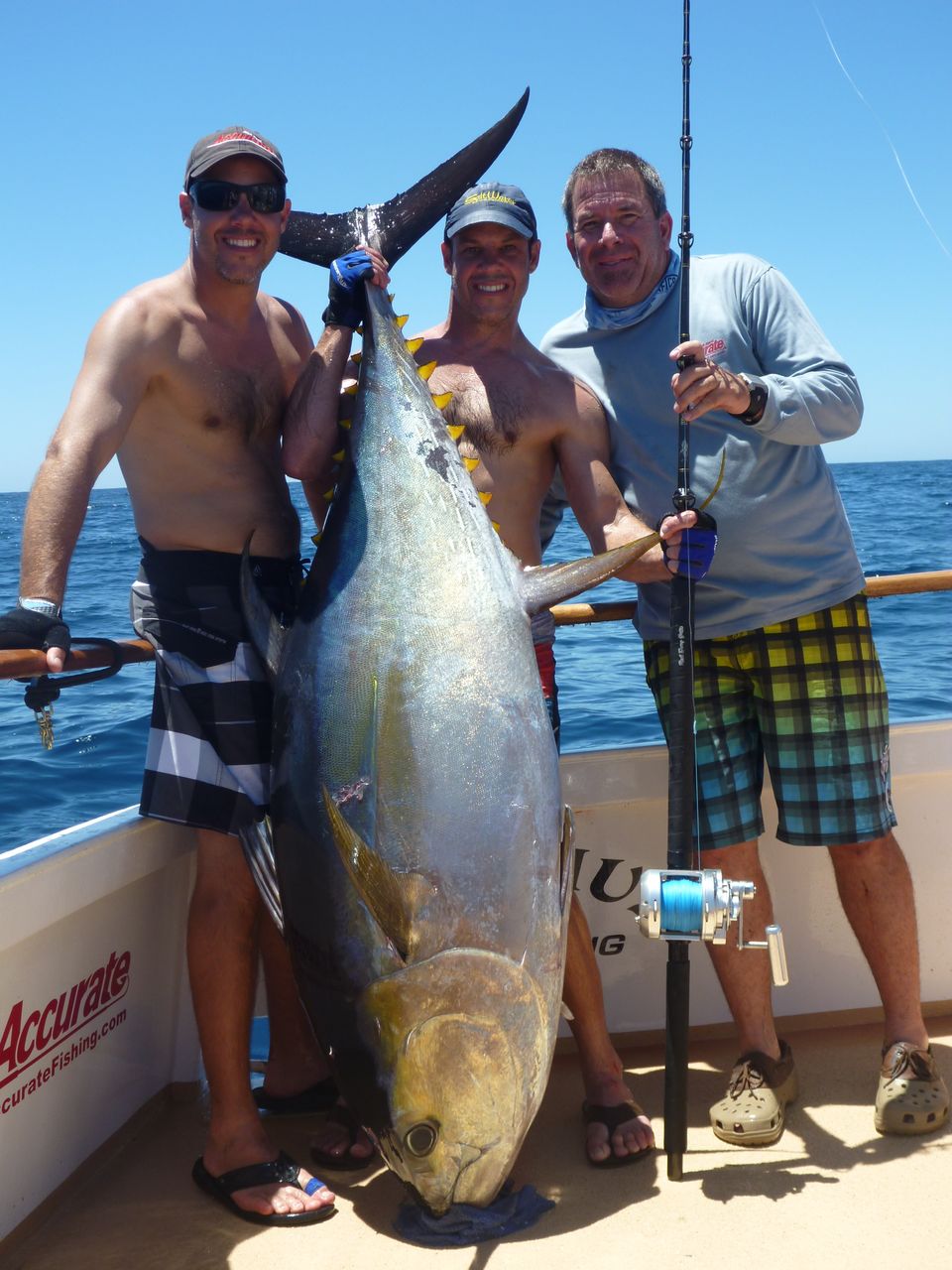Poppers for Pelagics’: West Coast Tuna Tackle
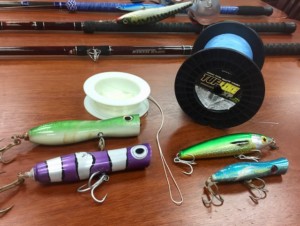
Popper fishing for big tuna is something that has been practiced, the Northeast Bluefin fishery and the Gulf Yellowfin fishery have been focal points of the technique. Puerto Vallarta is another location that saw anglers casting poppers in the past years but not until recently had it been a viable technique in the Southern California Bight with the introduction of larger Bluefin tuna.
The East Coast tuna fishery has predominantly been a spinning reel/rod fishery for the pure castibility of the poppers. Once the fish is hooked, it quickly separates the men from the boys when you start pulling on these beasts. The bluefin in the Northeast that are crashing the poppers on the surface often are in excess of 200 lbs, and even upwards of 400 lbs . Companies like AFTCO have developed harnesses exclusively for popper anglers so they can put the load from the pressure into their legs versus their back for these extended battles at often excessive drag pressure. The same goes for the Gulf fishery around Louisiana specifically out of South Pass, where they see Yellowfin tuna up to the 200 lb mark that are targeted on built up spinners and rods built for popper fishing.

On the West Coast we have not seen a fishery like this until recent years, as foaming Bluefin schools have been accessible to private boats and party boats alike. Along with the popper, a couple other surface lures have been extremely successful in catching these fish. The difference on the West Coast is that we use conventional lever drag reels with longer rods to cast poppers and stickbaits.
This blog will cover some of the tackle being used on the West Coast during the recent years of popper fishing and how the technique is evolving year to year.
When looking at the type of fish we are throwing poppers to, we first need to take into account if we are fishing off a party boat or a private boat. The last few years we have seen different types of opportunities to cast the poppers at fish, one of them being schools of what we have called “Foamers” which are fish that are focused on eating bait schools often anchovies and sardines which is sometimes the easiest opportunity since anything that hits the water is bit. Poppers because they are very aerodynamic can be casted long distances to the fish without spooking the school which ends up in a bite.
On a private boat, approaching the school slowly within distance then shutting the boat off allows for shorter rods of 7 1/2 to 8 feet work fine. The key is to get the optimal cast either to the side of the foamer or if possible right in the middle. Once the fish is hooked, the bluefin often take a straight run out and continue this until they tire. Unlike their Yellowfin cousins, we rarely see these fish settle into a circle under the boat. They either swim upswell or they to continue with the school. We see several different sizes of fish in one school. You can see true school fish in the 30 to 60 lb size foaming on top and right underneath them there are fish up to 200 lbs. In situations like this, guys will throw surface iron at these fish hoping for it to sink below the school fish, and get bit either on the sink, or straight winding the lure back to the boat by one of the larger models.

The other way we see the bluefin tuna is when they congregate on the surface which we call “shiners” since you can see them in the distance when their sides reflect the sunlight. This is a little different than the foamers since they fish will sink out when spooked from a distance. Foamers are focused on the bait school and the shiners are just swimming together on the surface. If you cast a popper right on top of one of these groups, it usually spooks the herd and you will have to wait for them to come back up again. It is crucial to understand which direction these fish are traveling in and to get in front of them. I have seen guys cast poppers way past the group and wait until they are in position to starting winding and popping. This type of approach gets bit often since they don’t hear a big splash and just react to the low pop of the lure. The positioning of the boat is most important and has to be done at low speeds/RPM’s not to spook the fish. We have often spent hours trying to get in position for the right cast, but once there with the right cast, it can often lead to a fish of a lifetime.

Bluefin will often be targeting a spread out school of bait and you will see them boiling all around an area but not all up together. Fan casting in an arc can also lead to a bite. Your best bet is to slide into the area and turn the boat off so they will not spook. Wait and see how the fish are acting, then figure out how to present the popper or topwater lure. This type of fishing will require a stick bait which is like a giant Zara spook (ultimate freshwater top water bait) from your childhood days. You can cast these lures out, (and this happens with poppers also), never move them, and a fish will blast them right on the surface. The key with any of these lures is to have 4X trebles as big as the lure will take without inhibiting the lure’s action. Some anglers like to use single hooks, some use the circle hooks, but what we have learned with treble hooks as once the fish eats the lure, the treble does the damage. Big Bluefin inhale the lure, often going down into their gullet or lodging around the gills. This will pretty much tear whatever area up creating pressure and they will swim towards the pressure. It makes them easier to fight on the lighter tackle, but the real trick will come when gaffing them at the boat. A green fish is a green fish no matter what. You are hoping that the location of the hook within their body has taken the fight out of them. Treble hooks will often peg their mouths shut upon the bite, hooking them in the top and bottom lip resulting in them drowning, unable to open their mouths to obtain water flow through their mouth and into their gills. The rigging of the lures is strictly up to the anglers and what they deem best for the fishery they are targeting. We are giving you ideas that have worked successfully for us in the last 5 years or so.
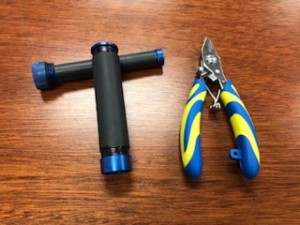
The difference on a party boat is that the rods need to be a little longer, (8 to 9 foot is pretty common), and the line capacity can be critical. Using reels that have as much line on them as possible while still being able to cast them effectively to foaming, shining, or boiling fish is key. This is where some anglers get into stacking braid, where they will put 65 lb braid on the bottom with a 100 yards of 80 lb on top. Once they get the 80 lb on the reel, they often put the drag up and put the heat on the fish, especially if they are hooked deep with a topwater lure. The 600 size reel has been extremely popular with 65 or 80 lb braid with a leader of 80 or 100 lb that is as long as the fish the plan on catching. Some guys used extremely short fluorocarbon leaders of 3 to 4 feet so they do not cast any knots going through the guides. This alleviates any possible wind knots that can happen when things are going off in front of the boat. Several well known guys in the private boat fleet do not even use leader and opt to cast straight braid at these fish. The choice of leader is up to the angler and what he thinks he can cast best.
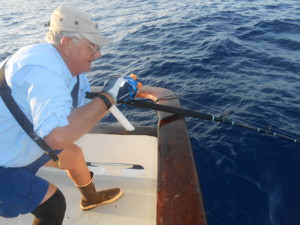
With the party boats, anglers do not have the ability to chase the fish, so a rod that has a good parabolic action coupled with line capacity will be the key. Many of these anglers will use the longer 9′ rod and make the cast that is required to get bit, then use the rail or corner of boat to apply pressure on the fish to move him closer to the boat so they can maximize the use of the rail. Once they get the fish where they can pressure him they get the rod on the rail and use it as a fulcrum and the rod as a lever. One popular comment on the party boats is “the rail is your friend”. This takes a lot of pressure off the angler, and gives the fish maximum pressure of the rod action / power. Bluefin are tricky and the bigger fish will take long runs all around the boat often ending in tangles that lose fish. The one thing to remember when fishing on party boats is to follow your line or fish so they are always in front of the angler. This is the bible on the boats as not to have other people get cut off by your line. Remember, the tackle you should use has to be comfortable for you so the size reel should fit your hand and the rod has to be something you can handle to cast. Good connections are key with either wind on leaders or solid knots with leaders. Not matter what, make sure all knots are cinched, and with heavy line use knot pullers to make sure all connections are solid.
 The West Coast tackle / lures consist of several different set ups, but here are some of the ones we have used with success:
The West Coast tackle / lures consist of several different set ups, but here are some of the ones we have used with success:
From the left to right of the photo:
Accurate BV2-800 with 800 yds of 80lb braid with wind on topshot of 100 lb fluoro leader coupled with a Seeker 6470H which is a heavier rated 40 to 60 lb rod, but handles 80 lb braid well. This rod works well for the private boater that is not casting extreme distances for bigger topwater bluefin. It is heavy enough to land a big fish, but easy to handle on the boat and casts great with the 800 size reel. This rod is solid on the rail on a skiff and not that bad to stand up and fight them when necessary.
Accurate BV2-800N with 550 yards of 80 lb braid and an 80 lb Fluorocarbon topshot with a Seeker 6480XH which is one of the universal set ups we use on both a private skiff and a party boat. The narrow reel with this 8 foot rod casts extremely well and is very lightweight. This combo is an absolute joy to fish with, especially casting the popper or stick bait.
Accurate DX2-600 with 375 yds of 80 lb braid with a small 3 to 4 foot piece of 80 lb Fluorocarbon leader and Cousins 8 foot 80XH jig stick . This set up works well for fish in the 60 to 150 lb range, but will also land bigger if necessary. The 8 foot rod has a parabolic action that is more forgiving when fighting a fish but has a great tip to cast a popper or surface iron on a group of foaming or boiling fish.
Accurate DX2-600N with 425 yds of 65 lb braid and a short 80 lb Fluorocarbon leader on a 9 foot Fishing Syndicate FSC 900H. This set up is perfect with the surface iron casting into foamers or boiling fish. This rod has a great tip for casting, but a slower more parabolic action that fits nicely on the rail once you are hooked up.
Accurate ATD-12 with 300 yds of 80 lb braid with 75 yards of 100 lb braid stacked on top with a 100 lb wind on fluorocarbon leader on a Seeker Ulua 93 9 foot rod. This set up was spawned in Puerto Vallarta on the late FV Maximus for larger yellowfin on the popper. The ATD-12 casts the popper great with this rod, but this set up is for the more advanced guys looking for max pulling power which you get drag wise from the ATD-12 and this 9 foot rod. This is definitely a railrod set up which has landed its fair share of cows (200lbs plus) both Yellowfin and Bluefin tuna.
There are a lot of rods and reels that will work great, but pick the ones that best fit you and your ability.
Remember to:
- Make sure your equipment is in top working order, check your reel, and look at the guides on your rod.
- When doing your connections, make sure all your knots are cinched.
- When putting your wind on leaders on, make sure all your lines are even on the Bimini and wind on for castibility.
- Don’t forget to have quality cutters and knot pullers on the boat to deal with heavier line.
- The rail is your friend either on a party or private boat. If you get tired, rest the rod on the rail.
- Take the appropriate tackle for the job at hand. Have two or three setups just in case.
- Make sure you listen to those that are experienced trying to help when you are fighting a fish, especially to the deckhands on the party boats.
- Most importantly, have fun and good luck on landing a fish of a lifetime.
Tight lines.
Team Accurate
 Custom Color Reels
Custom Color Reels
